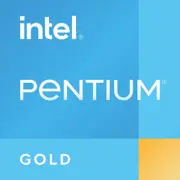Intel Pentium Gold G5500

Intel Pentium Gold G5500: Budget-Prozessor für grundlegende Aufgaben
April 2025
1. Hauptmerkmale: Architektur, Fertigungsprozess und zentrale Eigenschaften
Der Intel Pentium Gold G5500, der 2018 auf den Markt kam, bleibt aufgrund seines Preis-Leistungs-Verhältnisses eine beliebte Lösung für Budget-PCs.
Architektur und Fertigungsprozess
- Codename: Coffee Lake (14 nm).
- Kerntypen/Threads: 2 Kerne, 4 Threads (Hyper-Threading).
- Cache: 4 MB L3.
- Basisfrequenz: 3,8 GHz (ohne Turbo Boost).
Trotz des veralteten 14-nm-Fertigungsprozesses zeigt der Prozessor stabilen Betrieb bei einfachen Aufgaben. Hyper-Threading ermöglicht eine effizientere Verteilung der Lasten, was für ein Dual-Core-System entscheidend ist.
Integrierte Grafik
- Intel UHD Graphics 630: Unterstützung für 4K@60 Hz über HDMI/DisplayPort, hardwarebasierte Video-Decodierung (H.265, VP9).
- Gaming-Leistung: In Spielen wie CS:GO oder Dota 2 erreicht er 30-40 FPS bei niedrigen Einstellungen in Full HD.
Benchmarks
- Geekbench 6: 755 (einzelner Kern), 1496 (multithreading).
Zur Vergleich: AMD Athlon 3000G erzielt ungefähr 650 und 1250.
2. Kompatible Mainboards: Sockel und Chipsätze
Sockel: LGA 1151-v2 (nicht kompatibel mit Mainboards der 6. und 7. Generation von Intel).
Empfohlene Chipsätze:
- H310/B365: Budget-Option (ASRock H310CM-HDV, ~$60).
- B360/B365: Unterstützung für USB 3.1 Gen2 und eine höhere Anzahl an PCIe-Lanes (ASUS Prime B360M-A, ~$80).
- Z390: Für Enthusiasten, aber überflüssig für Pentium (Gigabyte Z390 UD, ~$120).
Wichtig:
- Aktualisieren Sie das BIOS vor der Installation, wenn das Board vor 2018 hergestellt wurde.
- Vermeiden Sie Chipsätze der H310-Serie mit eingeschränkter VRM-Stromversorgung — sie könnten das Potenzial des Prozessors nicht ausschöpfen.
3. Speicherunterstützung: DDR4 und Dual-Channel-Betrieb
- Speichertyp: DDR4-2400 (offiziell), aber viele Boards ermöglichen Übertaktung bis 2666 MHz.
- Maximaler Speicher: 64 GB (praktisch reichen 8-16 GB).
- Betriebsmodus: Verwenden Sie unbedingt zwei Module für den Dual-Channel-Betrieb (z. B. 2x4 GB).
Beispiel: Das Crucial DDR4-2400 8 GB-Set (2x4 GB) kostet etwa ~$35.
4. Netzteil: Leistungsberechnung
Bei einem TDP von 54 W und ohne dedizierte Grafikkarte reicht ein Netzteil mit 300-400 W aus.
Empfehlungen:
- Für eine Basis-Konfiguration: EVGA 400 W3 (80+ Bronze, ~$40).
- Mit zusätzlichem Platz für ein Upgrade: Corsair CX450 (450 W, ~$55).
Tipp: Sparen Sie nicht am Netzteil — niedrige Qualitätsmodelle (wie Apevia) können Komponenten beschädigen.
5. Vor- und Nachteile des Pentium Gold G5500
Vorteile:
- Preis: ~$60-80 (neu).
- Energieeffizienz: Geeignet für kompakte Gehäuse.
- Grafik UHD 630: Ersatz für eine Grafikkarte in Office-PCs.
Nachteile:
- 2 Kerne: Multitasking ist eingeschränkt (z. B. Streaming + Spiel — keine Option).
- 14 nm: Höhere Wärmeabgabe im Vergleich zu 10-nm-Alternativen.
6. Nutzungsszenarien
Büro und Multimedia:
- Arbeiten mit Dokumenten, Browser (20+ Tabs), Zoom-Konferenzen.
- Wiedergabe von 4K-Videos über VLC oder Kodi.
Leichte Spiele:
- Minecraft, Among Us, Stardew Valley — komfortables Spielen bei mittleren Einstellungen.
Server:
- NAS oder Heim-Mediaserver (z. B. basierend auf TrueNAS).
Einschränkungen:
- Videobearbeitung (DaVinci Resolve) oder 3D-Rendering (Blender) werden extrem langsam sein.
7. Vergleich mit Mitbewerbern
AMD Athlon 3000G:
- Vorteile: Günstiger (~$50), Grafik Vega 3.
- Nachteile: Schwächer bei Einzelkern-Benchmarks (~15%).
Intel Celeron G5905:
- Vorteile: Preis ~$45.
- Nachteile: Keine Hyper-Threading, Taktfrequenz 3,5 GHz.
Fazit: Der Pentium Gold G5500 ist optimal, wenn Sie ein ausgewogenes Verhältnis von Preis und Unterstützung moderner Technologien (4K, DDR4) benötigen.
8. Tipps zum Zusammenbauen
- Kühler: Der Box-Kühler ist ausreichend, aber für leisen Betrieb nehmen Sie den DeepCool GAMMAXX 400 (~$20).
- Speicher: SSD ist ein Muss (Kingston A400 240 GB, ~$25).
- Gehäuse: Micro-ATX (Fractal Design Core 1100, ~$50).
Beispielkonfiguration:
- Mainboard: ASRock H310CM-HDV ($60).
- Speicher: 8 GB DDR4 ($35).
- Netzteil: EVGA 400 W3 ($40).
- Insgesamt: ~$250 ohne Speicher und Gehäuse.
9. Fazit: Wer profitiert vom Pentium Gold G5500?
Dieser Prozessor ist die Wahl für:
1. Büro-PCs: Zuverlässigkeit und niedriger Energieverbrauch.
2. Heim-Mediacentern: 4K-Videos, Streaming.
3. Budget-Konfigurationen für Lernzwecke: Arbeiten mit Text, Browsing, leichten Anwendungen.
Warum man ihn nicht kaufen sollte:
- Wenn Sie Spiele mit AAA-Grafik planen.
- Für professionelle Aufgaben (Programmierung, Videobearbeitung).
Alternative für 2025: Ziehen Sie den Intel Processor N100 in Betracht (neu, 7 nm, aber teurer ~$120).
Der Pentium Gold G5500 ist ein Beispiel für eine gelungene Budgetlösung, die trotz ihres Alters für anspruchslose Benutzer nach wie vor relevant bleibt. Ihre Stärke liegt in Einfachheit, Stabilität und Minimalismus.
Basic
CPU-Spezifikationen
Speicherspezifikationen
GPU-Spezifikationen
Verschiedenes
Benchmarks
Im Vergleich zu anderen CPUs
In sozialen Medien teilen
Oder verlinken Sie uns
<a href="https://cputronic.com/de/cpu/intel-pentium-gold-g5500" target="_blank">Intel Pentium Gold G5500</a>